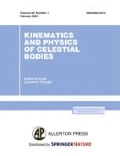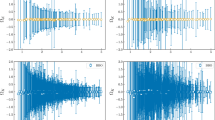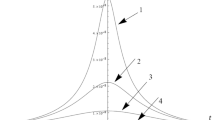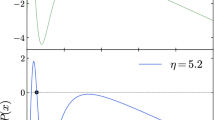Abstract
General relativity (GR) has a solid experimental base. However, the emergence of new experimental capabilities and independent observational information stimulates continuing tests of general relativity. The purpose of this work is to evaluate the potential of gravitational microlensing of distant sources on the stars of our Galaxy and to verify Einstein’s formula of gravitational refraction. This effect has been repeatedly tested in the Solar System in high-accuracy experiments with the propagation of radio waves, when the measurements are most effective for the distances from the signal trajectory to the Sun on the order of several solar radii. In the case of galactic microlensing, a quite different type of observational data and other characteristic distances are used that are determined in the high magnification events by the Einstein ring radii, which is typically of the order of 1 AU. Although the gravitational deflections of light by stars are very small and currently practically inaccessible by direct measurements, nonetheless, due to the large distances to the microlenses, the radiation flux from the source in strong microlensing events can increase several times. To verify Einstein’s formula, a more general dependence of the beam deflection angle \(\alpha \propto 1/{{p}^{{1 + \varepsilon }}}\) on its impact distance p relative to the deflector is considered and, accordingly, the equations of gravitational lensing are modified. The challenge is to limit ε based on observational data. The Early Warning System data obtained in 2018 within the Optical Gravitational Lensing Experiment (OGLE) (http://ogle.astrouw.edu.pl/ogle4/ ews/2019/ews.html) was used. A sample of 100 light curves from the data obtained by the OGLE group in 2018 was formed. Each light curve was fitted as part of a modified model of gravitational lensing with parameter ε. As a result, 100 values of ε and estimates of their variances were obtained. It was found that the mean value of ε does not contradict GR within the limits of a one percent standard deviation. In the future, using a larger number of light curves will allow one to hope for a significant decrease in the error of ε due to statistical averaging.

Similar content being viewed by others
REFERENCES
A. N. Aleksandrov, I. B. Vavilova, V. I. Zhdanov, A. I. Zhuk, Yu. N. Kudrya, S. L. Parnovskii, E. V. Fedorova, and Ya. S. Yatskiv, General Relativity Theory: Recognition through Time (Naukova Dumka, Kyiv, 2015) [in Russian].
A. N. Aleksandrov, V. I. Zhdanov, and V. M. Sliusar, “Verification of Einstein’s formula for gravitational deflection of light using observations of galactic microlensing,” Visn. Kyiv. Nats. Univ. Astron. 59 (1), 18–22 (2019).
C. Alcock, R. A. Allsman, D. Alves, T. S. Axelrod, D. Baines, A. C. Becker, D. P. Bennett, A. Bourke, A. Brakel, K. H. Cook, et al., “Binary microlensing events from the MACHO project,” Astrophys. J. 541, 270 (2000).
V. M. Shulga, V. I. Zhdanov, A. N. Alexandrov, P. P. Berczik, E. P. Pavlenko, Ya. V. Pavlenko, L. S. Pilyugin, and V. S. Tsvetkova, Dark Energy and Dark Matter in the Universe: In Three Volumes, Vol. 2: Dark Matter: Astrophysical Aspects of the Problem, Ed. by V. Shulga (Akademperiodyka, Kyiv, 2014), ch. 1–2.
S. Dong, A. Mérand, F. Delplancke-Ströbele, A. Gould, P. Chen, R. Post, C. S. Kochanek, K. Z. Stanek, G. W. Christie, R. Mutel, et al., “First resolution of microlensed images,” Astrophys. J. 871, 70 (2019).
A. Einstein, “Die Grundlage der allgemeinen Relativitätstheorie,” Ann. Phys. (Berlin, Ger.) 49, 769–822 (1916).
E. Fedorova, V. M. Sliusar, V. I. Zhdanov, A. N. Alexandrov, A. Del Popolo, and J. Surdej, “Gravitational microlensing as a probe for dark matter clumps,” Mon. Not. R. Astron. Soc. 457, 4147–4159 (2016).
B. S. Gaudi, “Microlensing surveys for exoplanets,” Annu. Rev. Astron. Astrophys. 50, 411 (2012).
C. R. Keeton and A. O. Petters, “Formalism for testing theories of gravity using lensing by compact objects. I: Static, spherically symmetric case,” Phys. Rev. D 72, 104006 (2005).
C. R. Keeton and A. O. Petters, “Formalism for testing theories of gravity using lensing by compact objects. II: Probing Post-Post-Newtonian metrics,” Phys. Rev. D 73, 044024 (2006).
H. Liu, X. Wang, H. Li, and Y. Ma, “Distinguishing f(R) theories from general relativity by gravitational lensing effect,” Eur. Phys. J. C 77, 723 (2017).
M. Lubini, C. Tortora, J. Näf, P. Jetzer, and S. Capozziello, “Probing the dark matter issue in f(R)-gravity via gravitational lensing,” Eur. Phys. J. C 71, 1834 (2011).
M. Milgrom, “Testing the MOND paradigm of modified dynamics with galaxy-galaxy gravitational lensing,” Phys. Rev. Lett. 111, 041105 (2013).
B. Paczyński, “Gravitational microlensing by the galactic halo,” Astrophys. J. 304, 1–5 (1986).
Sh. Poindexter, C. Afonso, D. P. Bennett, J.-F. Glicenstein, A. Gould, M. K. Szymański, and A. Udalski, “Systematic analysis of 22 microlensing parallax candidates,” Astrophys. J. 633, 914 (2005).
P. Schneider, J. Ehlers, and E. E. Falco, Gravitational Lenses (Springer-Verlag, Berlin, 1992).
M. C. Smith, Sh. Mao, and B. Paczyński, “Acceleration and parallax effects in gravitational microlensing,” Mon. Not. R. Astron. Soc. 339, 925 (2003).
Y. Tsapras, A. Cassan, C. Ranc, E. Bachelet, R. Street, A. Udalski, M. Hundertmark, V. Bozza, J. P. Beaulieu, J. B. Marquette, et al., “An analysis of binary microlensing event OGLE-2015-BLG-0060,” Mon. Not. R. Astron. Soc. 487, 4603 (2019).
A. Udalski, M. Szymański, J. Kaluzny, M. Kubiak, W. Krzemiński, M. Mateo, G. W. Preston, and B. Paczyński, “The optical gravitational lensing experiment. Discovery of the first candidate microlensing event in the direction of the galactic bulge,” Acta Astron. 43, 289–294 (1993).
A. Udalski, M. K. Szymański, and G. Szymański, “OGLE-IV: Fourth phase of the optical gravitational lensing experiment,” Acta Astron. 65, 1–38 (2015).
C. M. Will, “The confrontation between general relativity and experiment,” Living Rev. Relativ. 17, 4 (2014).
ACKNOWLEDGMENTS
This study relies essentially on data obtained in 2018 during the implementation of the Optical Gravitational Lensing Experiment, Phase IV Program (http://ogle.astrouw.edu.pl/ogle4/ews/ews.html) [19, 20].
Funding
The work was carried out within the framework of project no. 19BF023-01 of the Astronomy and Physics of Space Program of the National Taras Shevchenko University of Kiev.
Author information
Authors and Affiliations
Corresponding author
Additional information
Translated by E. Seifina
About this article
Cite this article
Alexandrov, A.N., Zhdanov, V.I. & Sliusar, V.M. Verification of Einstein’s Formula for Gravitational Deflection of Light Using Observations of Galactic Microlensing. Kinemat. Phys. Celest. Bodies 36, 205–211 (2020). https://doi.org/10.3103/S0884591320050025
Received:
Revised:
Accepted:
Published:
Issue Date:
DOI: https://doi.org/10.3103/S0884591320050025




